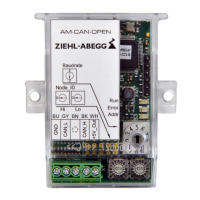6.2.1 CANopen Profile
The CANopen profile defines the elements related to the available services as will as to the Node_ID.
The Node_ID is the device address in the CANopen terminology. The COB_IDs are derived from the
Node_ID.
The profile parameters are defined by the following steps:
1. After reset, the profile which was saved in the source code of the microcontroller as a standard is
loaded from the ROM. The elements related to the Node_ID have the standard address 126. The
COB_IDs are defined in agreement with the CANopen standard.
2. If the switch position "0" is detected, the Flash memory is cleaned and then no more data are
available.
3. If a switch position > 0 is detected, the application searches for data in the Flash memory. If valid
data are found, these are used for the CANopen profile. However, only the elements with
write/read access rights ("RW") are updated.
4. If the switch position 127 is detected, the above named settings are retained and the device
switches to the ready to operate mode. Full write access is granted here.
5. To enable easier starting, it is possible to set the switch to a position between 1 and 126. In this
case the elements in relation to the Node_ID are overwritten. The COB_IDs are derived accord-
ingly from the CANopen standard. The elements concerned are listed in the table "Predefined
settings by the address switch".
6. There is an integrated SDO service with which the profile can be modified. These changes are
made exclusively in the RAM and become effective immediately. In order to change the setting
permanently, it has to be saved in the Flash memory. Object 0x1010 can be used to save to the
Flash memory.
Information
The LSS (Layer Setting Service) is necessary to modify the Node_ID or the baud rate.
Operating Instructions AM-CAN-OPEN – model series Communication
L-BAL-E199-GB 1846 Index 005 Part.-No. 00163405-GB
9/28

